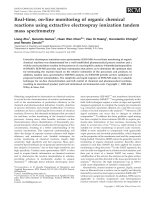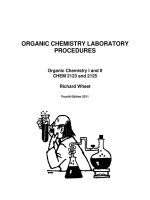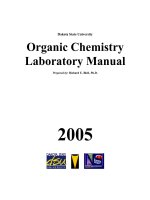38516885 organic i reactions COMPLETE pdf
Bạn đang xem bản rút gọn của tài liệu. Xem và tải ngay bản đầy đủ của tài liệu tại đây (67.48 KB, 10 trang )
Facilitator: Chris Lovero
Organic Chemistry Reactions
Task
Reaction
Notes
*Adds a halide
Addition of HX
(Mark)
H
H
H
HBr
Br
CH3
H
Addition of HX
H
CH3
H
H
Add two Br's anti
CH3
to alkene
ROOR
H
CH3
CH3
Br2
CH3
CH3
OH (Mark w/ Br as H
Br2
Forming alkene
H2O
from vicinal dihalide
H3C
*Wedges with wedges
Br
H
Br
*Anti and co planar
OH
D
Br
and anti-planar)
D
*Anti and co planar
Br
D
Br
(or CCl4)
Adding a Br and
to least substituted
carbon.
H H
CH2Cl2
D
*Adds a halide
Br H
HBr
CH3
carbon.
H H
(Anti-Mark)
H
to more substituted
H
NaI or KI
CH3
acetone
H
H
H3C
CH3
and dashes with dashes
*E2 Like!
*E1 like and it cannot
Dehydration to
H2SO4
alkene
OH
give terminal alkene
heat
*SPECIAL REACTION:
OH
Addition of OH
(direct and mark)
POCl3
dehydrates to form
heat
terminal alkene.
*CANNOT CONTROL
CH3
CH3
CH3
H3O+
CH3
STEREOCHEM!
*Low yield!
OH
*C+ formation!
1
Facilitator: Chris Lovero
Organic Chemistry Reactions
Task
Reaction
Oxymercuration/
CH3
demercuration
Notes
CH3
OH
1) Hg(OAc)2/ H2O
(Add OH from alkene
2) NaBH4
mark and antiplanar)
CH3
O CH3
CH3
SPECIAL: Adds alcohol
1) Hg(OAc)2/ CH3OH
instead to form ethers!
2) NaBH4
D
D
*Mark and antiplanar
H
D
D
*Complex mechanism
H
*Complex mechanism
*Mark and antiplanar
*WILL BE SEEING THIS
MORE IN ORGO II
*Anti-mark
Hydroboration
D
D
(Add Oh anti-mark and
CH3
syn planar)
CH3
1) BH3 / THF
H
2) H2O2 / -OH
Catalytic Hydrogenation
H 3C
CH3
H3 C
(Alkenes -> Alkane, Syn
D
Pt, Pd, or Ni
CH3
CH3
*Steric factors must be
payed attention to
D
H2
Addition of H)
*Notice Peroxide
OH
*Can use D2 instead
H3 C
H
H
*expensive
Formation of
CH3
Vicinal Diols
OsO4
(Syn)
H2O2
D
CH3
KMnO4
D
cold, basic
OH
CH3
*toxic
*great yield
D OH
OH
CH3
D OH
*cheaper
*safer
*poor yield
2
Facilitator: Chris Lovero
Organic Chemistry Reactions
Task
Ozonolysis
Reaction
R
R
Notes
O
1) O3 / CH2Cl2
(double bond cleavage)
+
R
R
R
R
R
R
R
1) O3 / CH2Cl2
O
O
Warm KMnO4
H
R
H
R
H
R
R
2) (CH3)2S
R
1) O3 / CH2Cl2
O
2) (CH3)2S
+
*Can isolate the
formaldehyde.
R
H
+
R
*Can use Zn/acetic acid
instead of (CH3)2S
R
2) (CH3)2S
R
R
O
O
H
R
H
O
O
*further oxidizes to form
KMnO4
cleavage
R
warm
R
+
R
R
R
R
carboxylic acids
*cannot isolate the
formaldehyde
R
R
R
H
R
H
R
KMnO4
O
R
warm
warm
addition (formation of
cyclopropane)
R
OH
O
+ CO2 +
R
H2O
R
Carbene / Carbenoid
CH3
O
R
KMnO4
H
+
CH3
CH2N2
the Simmons-Smith
D
H3C
*stereochem is preserved
*Second reaction uses
heat
H
*syn
D
CH3
CH2I2
Zn(Cu)
D
H
reagent
CH3
D
H3C
*useful for synthesis
Formation of epoxides
from alkenes
CH3
CH3
MCPBA
ORGO II)
O
D
(ESPECIALLY IN
D
3
Facilitator: Chris Lovero
Organic Chemistry Reactions
Task
Reaction
Notes
O
to form ethers. You
H2O
OH
CH3
OH
O
2)H3O+
Formation of
H3C
CHCl3
*please look up the
Cl
Cl
CH3
mechanism so you can
H
CH3
KOH
D
D
H 3C
CH3
see how the carbene
is formed
CH3
Br
CHBr3
KOH
D
Br
D
*forms the nucleophile
Formation of the
acetylide anion
mechanism.
D
OH
D
H
*Please look up
CH3
1) OH
Dichlorocarbenes
*Basic are like SN2
(least substituted side)
-
Dibromocarbenes and
side.
D
D
will see this in Orgo II.
from more substituted
OH
H3O+
NOTE: Can use RO-
*acidic conditions opens
CH3
CH3
Opening of Epoxides
H 3C C
NaNH2
C H
H3C C
C
-
that is handy when
connecting carbons!
Uses of the acetylide
anion
*SN2 because of the
with methyl or 1o halides
H 3C C
C
-
CH3Br
C CH3
exception we learned
from before!!!!
with 2o or 3o halides
H 3C C
H3C C
C
Br
-
*E2 remember from last
H3C CH CH3
CH2
H3C CH
with carbonyl groups (ketones, aldehydes, and formaldehydes)
*acetylide anion attacks
HO
O
H3C C CH3
1) H3C
C
2) then H3O+
-
C
test!!!
H3C
partially positive carbon
C CH3
*DO NOT FORGET
C
then H3O+
C
H3C
4
Facilitator: Chris Lovero
Organic Chemistry Reactions
Task
Reaction
Notes
*Need either geminal or
Synthesis of Alkynes
Br Br
1) NaNH2 / 100oC
H3C CHCH CH3
2) H3O+
vicinal dihalides
C CH2 CH3
HC
*Look up mechanism
*NaNH2 gives terminal
Br Br
*KOH gives internal
CH2CHCH2CH3
Br
H3C C CH2 CH3
Br
Br
KOH
HC CH2 CH2CH3
200oC
Br
Halogenation of alkynes
Br2 and alkyne
H 3C
C
C
H 3C
CH3
H
*Stereochem cannot
be controlled
H 3C
C
C
H
Br
Br2
(1 eq)
Br
+
Br
H
H 3C
HBr and alkyne
Br
Br
HBr
H
*syn addition
(1 eq)
H 3C
C
C
H 3C
H
*Mark
H
Br
HBr
(2 eq)
Br
*Anti mark
HBr and alkyne
HBr
H 3C
C
C
H
ROOR
H
H 3C
Br
*syn addition
H
*Takes it all the way back
Catalytic reduction with
reactive catalyst
H 3C
C
C
CH3
H2
to alkane
*generally bad yield
Pt, Pd, or Ni
5
Facilitator: Chris Lovero
Organic Chemistry Reactions
Task
Reaction
Alkyne to Alkene:
Lindlar's catalyst
TRIPLE to DOUBLE
H 3C
C
Notes
*isolates an alkene with
C
H2 / Pd(BaSO4)
CH3
quinoline
H
H
a SYN addition of H
H 3C
CH3
H
CH3
*isolates an alkene with
Dissolving metal
H 3C
C
C
NaNH3
CH3
H 3C
Addition of H-OH to
alkynes
H
Mercuric Ion
HgSO4 / H2O
H3C CH2 C
C
H
H2SO4
an ANTI addition of H
O
*Mark addition
C
*If not terminal, you will
CH3
H3C CH2
get a mixture.
*Formation of ketone
H3C CH2 C
C
CH3
HgSO4 / H2O
O
H2SO4
C
CH2 CH3
H3C CH2
+
O
C
CH3
H3C CH2 CH2
Hydroboration
*Antimark addition
O
1) Sia2BH
H3C CH2 C
C
H
2) H2O2 / -OH
*will get a mixture if not
C
H3C CH2 CH2
H
terminal
*Formation of aldehyde
Oxidation of alkynes
(mild conditions)
H 3C
C
C
CH3
*Forms vicinal
O
KMnO4 / H2O
carbonyls
neutral / cold
*further oxidizes terminal
O
alkynes to form
carboxylic acid.
H 3C
C
C
H
O
KMnO4 / H2O
neutral / cold
OH
O
6
Facilitator: Chris Lovero
Organic Chemistry Reactions
Task
Cleavage of Alkynes:
Reaction
Notes
Oxidation of alkyne (strong)
H 3C
C
*Forms H2O and CO2
O
C CDH2
1) KMnO4 / H2O
if terminal.
H 3C
2) -OH / heat
OH
+
O
CDH2
HO
H 3C
C
C
H
1) KMnO4 / H2O
O
-
2) OH / heat
H 3C
C CDH2
C
C
C
H
1) O3
H
H3C CH
from Grignard
*Same products as
previous
CDH2
+
H 2O
+
CO2
OH
*Forms from 1o, 2o, 3o,
H
H3C CH
C
allyl, vinyl, and aryl
MgBr
The Organolithium
Formation of alcohols
+
O
ether
Br
CO2
O
Mg
C
+
OH HO
2) H2O H3C
2) H2O
The Grignard Reagent
Reagent
O
1) O3
H 2O
OH
Ozonolysis
H 3C
+
*This reagent acts like
Li
H3C CH2
Br
pentane or hexane
H3C CH2
Li
1o alcohols. (Grignard and formaldehyde)
1)
H
*Carbon attachment
H
2) H3O+
OH
2o alcohols. (Grignard and aldehyde)
*Know this mechanism!
O
MgBr
1)
*Carbon attachment
H
2) H3O+
OH
3o alcohols. (Grignard and ketone)
*Know this mechanism!
O
MgBr
grignard but is stronger.
*Know this mechanism!
O
MgBr
carbons.
*Carbon attachment
1)
2) H3O+
OH
7
Facilitator: Chris Lovero
Organic Chemistry Reactions
Task
Reaction
Notes
*Reaction goes until
Grignard and esters
O
OH
MgBr
completion
or acid halides
OCH3 1)
*Know this mechanism!
2) H3O
+
Grignard and Epoxides
(opening of epoxides)
*SN2 like (attacks least
O
MgBr
1)
OH
2) H3O+
*Know this mechanism!
*This is just good to
Attaching Deuterium to
carbons
substituted side)
D2O
MgBr
H 3C
Corey-House Reaction
Li
CH3Br
H 3C
CuI
CH3Li
D
know.
*not well understood
(CH3)2CuLi
(do not need to know
mechanism)
+
Br
*another way to attach
carbons.
Hydride reduction of
*reduces only
mild conditions (NaBH4 as reagent)
carbonyls
O
aldehydes and
OH
NaBH4
ketones.
EtOH
*use alcohols as a
O
NaBH4
solvent.
no reaction
EtOH
Cl
*reduces aldehydes,
strong conditions (LiAlH4 as reagent)
ketones, esters, acid
O
OH
1) LiAlH4 / ether
halides, carboxyllic
2) H3O+
acids.
OH
*Use ethers solvents
O
O
+
1) LiAlH4 / ether
2) H3O+
OH
OH
*Two step process
8
Facilitator: Chris Lovero
Organic Chemistry Reactions
Task
Raney Nickel
Reaction
Notes
*Reduces both carbonyl
O
H2
OH
and alkene.
Ra-Ni
Oxidation of alcohols
*any [ox] can be used
2o alcohols
Na2CrO7
*KMnO4 and NO3 can
H2SO4 / H2O
OH
be used but they are
harsh.
CrO3 / H2SO4 / H2O
O
acetone / 0oC
(Jones reagent)
PCC
CH2Cl2
1o alcohols
*PCC is the only one
Na2CrO7
H2SO4 / H2O
that can isolate
OH
the formaldehyde.
O
CrO3 / H2SO4 / H2O
OH
acetone / 0oC
(Jones reagent)
H
PCC
O
CH2Cl2
Formation of the
*RETENTION from
Tosylate Ester
OH
TSCl
OTos
where alcohol was
originally (SN2
purposes)
Formation of alkyl halide
from 3o alcohols
OH
HCl / ether
0oC
Cl
9
Facilitator: Chris Lovero
Organic Chemistry Reactions 10
Task
Reaction
Notes
*Basically an SN2
Formation of 1o/2o
PBr3
alkyl halides from 1o/2o
Br CH3
reaction. (Inversion
CH2Cl2
from original alcohol)
alcohols
*Can also use SOCl2
PCl3
H3C OH
CH2Cl2
Cl CH3
for Cl, but it undergoes
a special mechanism!
P / I2
I
CH3
CH2Cl2
Unique cleavage with
O
OH
CH3
HIO4
HIO4
*Vicinal diols must
CH3
be syn
OH
H
H
O
Formation of Alkoxide
1o or 2 o alcohols
Nao
OH
Anion
O
Ko
2o or 3o alcohols
O
OH
O
Williamson ether
synthesis
-
-
*Basically that SN2
Br
H 3C
-
exception we learned
O
in test 2
*Must be identical
Ethers from intermolecular
dehydration
2x CH3CH2-OH
H2SO4
CH3CH2-O-CH2CH3
140oC
Pinacol - Pinacolone
O
OH OH
Rearrangement
alcohols or else you
will get a mixture!!!
*Need vicinal diols
*Know mechanism
H2SO4
(methyl shift!)
Fischer Estherification
H 3C
CH2 OH
C
O
*CAN USE ACID
+
H3C CH2 O
+
HO
H
CH3
C
O
CH3
HALIDE instead of
carboxyllic acid!!!









